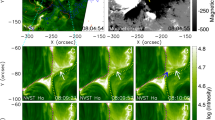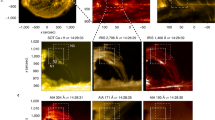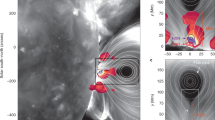Abstract
Solar flares are intense bursts of electromagnetic radiation accompanied by energetic particles and hard X-rays. They occur when magnetic flux loops erupt in the solar atmosphere. Solar observations detect energetic particles and hard X-rays but cannot reveal the generating mechanism because the particle acceleration happens at a scale smaller than the observation resolution. Thus, details of the cross-scale physics that explain the generation of energetic particles and hard X-rays remain a mystery. Here, we present observations from a laboratory experiment that simulates solar coronal loop physics. Transient, localized 7.6-keV X-ray bursts and a several-kilovolt voltage spike are observed in braided magnetic flux ropes of a 2-eV plasma when the braid strand radius is choked down to be at the kinetic scale by either magnetohydrodynamic (MHD) kink or magnetic Rayleigh–Taylor instabilities. This sequence of observations reveals a cross-scale coupling from MHD to non-MHD physics that is likely responsible for generating solar energetic particles and X-ray bursts. All the essential components of this mechanism have been separately observed in the solar corona.
This is a preview of subscription content, access via your institution
Access options
Access Nature and 54 other Nature Portfolio journals
Get Nature+, our best-value online-access subscription
$29.99 / 30 days
cancel any time
Subscribe to this journal
Receive 12 digital issues and online access to articles
$119.00 per year
only $9.92 per issue
Buy this article
- Purchase on Springer Link
- Instant access to full article PDF
Prices may be subject to local taxes which are calculated during checkout





Similar content being viewed by others
Data availability
The experimental data reported here were generated by the Caltech Solar Loop Experiment and have been uploaded to https://data.caltech.edu/records/rcrh7-7ps89.
Code availability
Information about LTspice circuit simulation software is available at https://www.analogue.com/en/design-centre/design-tools-and-calculators/ltspice-simulator.html.
References
Cirtain, J. W. et al. Energy release in the solar corona from spatially resolved magnetic braids. Nature 493, 501–503 (2013).
Testa, P. et al. Evidence of nonthermal particles in coronal loops heated impulsively by nanoflares. Science 346, 1255724 (2014).
Fleishman, G. D. et al. Decay of the coronal magnetic field can release sufficient energy to power a solar flare. Science 367, 278–280 (2020).
Bahauddin, S. M., Bradshaw, S. J. & Winebarger, A. R. The origin of reconnection-mediated transient brightenings in the solar transition region. Nat. Astron. 5, 237–245 (2021).
Fleishman, G. D., Nita, G. M., Chen, B., Yu, S. & Gary, D. E. Solar flare accelerates nearly all electrons in a large coronal volume. Nature 6, 674–677 (2022).
Lemen, J. R. et al. in The Solar Dynamics Observatory (Eds Pesnell, W. D. et al.) 17–40 (Springer, 2011).
Kobayashi, K. et al. The high-resolution coronal imager (Hi-C). Solar Phys. 289, 4393–4412 (2014).
Parker, E. Magnetic neutral sheets in evolving fields. I. General theory. Astrophys. J. 264, 635–647 (1983).
Parker, E. Nanoflares and the solar X-ray corona. Astrophys. J. 330, 474–479 (1988).
Alfvén, H. & Carlqvist, P. Currents in the solar atmosphere and a theory of solar flares. Solar Phys. 1, 220–228 (1967).
Carlqvist, P. Current limitation and solar flares. Solar Phys. 7, 377–392 (1969).
Stenson, E. V. & Bellan, P. Magnetically driven flows in arched plasma structures. Phys. Rev. Lett. 109, 075001 (2012).
Ha, B. N. & Bellan, P. M. Laboratory demonstration of slow rise to fast acceleration of arched magnetic flux ropes. Geophys. Res. Lett. 43, 9390–9396 (2016).
Wongwaitayakornkul, P., Haw, M. A., Li, H., Li, S. & Bellan, P. M. Apex dips of experimental flux ropes: helix or cusp? Astrophys. J. 848, 89 (2017).
Haw, M. A., Wongwaitayakornkul, P., Li, H. & Bellan, P. M. Reverse current model for coronal mass ejection cavity formation. Astrophys. J. Lett. 862, L15 (2018).
Wongwaitayakornkul, P., Haw, M. A., Li, H. & Bellan, P. M. Magnetically induced current piston for generating extreme-ultraviolet fronts in the solar corona. Astrophys. J. 874, 137 (2019).
Zhang, Y., Wongwaitayakornkul, P. & Bellan, P. M. Magnetic Rayleigh–Taylor instability in an experiment simulating a solar loop. Astrophys. J. Lett. 889, L32 (2020).
Newcomb, W. A. Hydromagnetic stability of a diffuse linear pinch. Ann. Phys. 10, 232–267 (1960).
Zhou, Y., Pree, S. & Bellan, P. M. Imaging suprathermal X-rays from a laboratory plasma jet using PIN-diode-based and scintillator-based 1D pinhole/coded aperture cameras. Rev. Sci. Instruments 94, 013504 (2023).
Henke, B. L., Gullikson, E. M. & Davis, J. C. X-ray interactions: photoabsorption, scattering, transmission, and reflection at E = 50–30,000 eV, Z = 1–92. Atomic Data Nuclear Data Tables 54, 181–342 (1993).
Buneman, O. Dissipation of currents in ionized media. Phys. Rev. 115, 503–517 (1959).
Engelhardt, M. LTspice owned by Analog Devices Inc. Version 17.1.8 https://www.analog.com/en/design-center/design-tools-and-calculators/ltspice-simulator.html (2023).
Moser, A. L. & Bellan, P. M. Magnetic reconnection from a multiscale instability cascade. Nature 482, 379–381 (2012).
Kruskal, M. D. & Schwarzschild, M. Some instabilities of a completely ionized plasma. Proc. Royal Soc. Lond. Ser. A Math. Phys. Sci. 223, 348–360 (1954).
Ryutov, D., Drake, R. & Remington, B. Criteria for scaled laboratory simulations of astrophysical MHD phenomena. Astrophys. J. Suppl. Ser. 127, 465 (2000).
Sullivan, C. R. & Zhang, R. Y. Simplified design method for litz wire. In 2014 IEEE Applied Power Electronics Conference and Exposition-APEC 2014 2667–2674 (IEEE, 2014).
Stix, T. H. Magnetic braiding in a toroidal plasma. Phys. Rev. Lett. 30, 833 (1973).
Aschwanden, M. Physics of the Solar Corona: An Introduction with Problems and Solutions (Springer Science & Business Media, 2006).
Srivastava, A., Zaqarashvili, T., Kumar, P. & Khodachenko, M. Observation of kink instability during small B5.0 solar flare on 2007 June 4. Astrophys. J. 715, 292 (2010).
Hillier, A. The magnetic Rayleigh–Taylor instability in solar prominences. Rev. Modern Plasma Phys. 2, 1 (2018).
Kumar, P., Cho, K.-S., Bong, S.-C., Park, S.-H. & Kim, Y. Initiation of coronal mass ejection and associated flare caused by helical kink instability observed by SDO/AIA. Astrophys. J. 746, 67 (2012).
Lin, R. P. et al. in The Reuven Ramaty High-Energy Solar Spectroscopic Imager (RHESSI) (Eds Lin, R. P. et al.) 3–32 (Springer, 2003).
Ergun, R. et al. Observations of double layers in Earth’s plasma sheet. Phys. Rev. Lett. 102, 155002 (2009).
Acknowledgements
This material is based upon work supported by the NSF (Awards 1914599 and 2105492 to P.M.B.). The X-ray detector used in this work was developed with support from the USDOE ARPA-E (Grant DE-AR0001159 to P.M.B.).
Author information
Authors and Affiliations
Contributions
Y.Z. designed the braided loop experiment from the suggestions and guidance of P.M.B. S.P. built the X-ray camera from the suggestions and guidance of P.M.B. Y.Z. and S.P. performed the experiment. The interpretation of the results was done jointly by all authors. Y.Z. drafted the manuscript. All authors revised the manuscript together.
Corresponding author
Ethics declarations
Competing interests
The authors declare no competing interests.
Peer review
Peer review information
Nature Astronomy thanks Markus Aschwanden and the other, anonymous, reviewer(s) for their contribution to the peer review of this work.
Additional information
Publisher’s note Springer Nature remains neutral with regard to jurisdictional claims in published maps and institutional affiliations.
Extended data
Extended Data Fig. 1 Solar loop experiment circuit simulation.
(a) Experiment circuit diagram. The plasma part of the circuit is represented as an inductor and a time-dependent resistor. The plasma inductance is assumed to be 50 nH, which is obtained by simplifying the plasma loop as a half circle loop of wire with 5 cm loop major radius and 1 cm minor (wire) radius. The voltage and current spikes are both peak functions, so the corresponding resistance change is presumed to be also a peak function. We use Gaussian function \({R}_{plasma}={R}_{0}\exp (-a{(t-{t}_{0})}^{2})\) to represent the transient change of the plasma resistance where R0 is the peak resistance value, and t0 is the resistance peak time, and a is related to the full width at half maximum (FWHM). They are chosen according to the relative voltage spike amplitude, voltage peak time and the voltage spike FWHM. In the simulation, R0 = 0.4Ω, t0 = 3.65 μs and a = 5 μs −2 are used. The corresponding plasma resistance is plotted in (b). (c, d) Voltage and current measurement from experiment Shot # 9258. As shown in (a), the voltage measured in (c) is the voltage across the plasma part and an extra inductor. We also measured the voltage across the plasma part by connecting two voltage probes directly to the top electrode and bottom electrode and then subtracting the two voltages. The voltage trace across the plasma is similar but has a several kV larger voltage spike compared with (c). (e, f) Voltage and current curves from the simulation. Voltage and current spikes similar to the experimentally observed spikes are reproduced by the transient resistance increase.
Extended Data Fig. 2 Magnetic Rayleigh Taylor instability observation.
A four-strand braided structure is shown in time series images of hydrogen plasma loop evolution. With the expansion of the plasma loop, a magnetic Rayleigh Taylor instability occurs on the loop and plays the same role as a kink instability to choke the strand radius down and break the strand at later time. The full evolution video can be found in Supplementary Movie 2.
Supplementary information
Supplementary Video 1
This video shows an example of braided plasma loop evolution where a kink instability develops on the top of the loop starting at around 2.68 μs.
Supplementary Video 2
This video shows an example of braided plasma loop evolution where a magnetic Rayleigh–Taylor instability develops on the loop starting at around 2.54 μs.
Rights and permissions
Springer Nature or its licensor (e.g. a society or other partner) holds exclusive rights to this article under a publishing agreement with the author(s) or other rightsholder(s); author self-archiving of the accepted manuscript version of this article is solely governed by the terms of such publishing agreement and applicable law.
About this article
Cite this article
Zhang, Y., Pree, S. & Bellan, P.M. Generation of laboratory nanoflares from multiple braided plasma loops. Nat Astron 7, 655–661 (2023). https://doi.org/10.1038/s41550-023-01941-x
Received:
Accepted:
Published:
Issue Date:
DOI: https://doi.org/10.1038/s41550-023-01941-x



